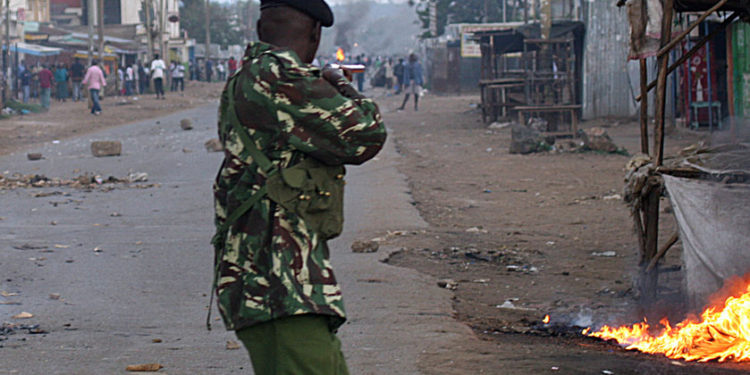By Joyce J Wangui
A dry smile papers over the embarrassment washing Charles Ondieki Gechemba’s face as he looks down on his crutches — unable to rise to usher visitors into his living room. At 65, Ondieki is not an old man but the former mason has aged beyond his years.
.jpg)
Before the crutches arrived, donated by a charity organisation, Ondieki would repeatedly fly into fits of inexplicable rage that were neither deserved nor directed.
“We used to take turns to carry him to the toilet and even stand by to wait for him, something that was so shameful for his children to watch,” says his wife Moraa.
Juggling housework with banana and tomato farming, as well as finding a market for her produce has to fit together with Moraa constantly caring for her husband.
Ondieki, a father of five, can still work with his hands, but it is his mind his family worries most about.
He confesses that he feels deeply ashamed of his body, but is also weighed down by the loss of power as a man.
One afternoon, nine years ago, three Administration Police officers stormed into Ondieki’s compound to rescue a neighbour allegedly held captive over a dispute.
The officers had been told that Ondieki had locked up the neighbour in one of the rooms in his house, intending to call elders to resolve the matter of the four-acre piece of land.
The officers stormed Ondieki’s house, manhandled him, and beat him to within an inch of his life. When his youngest son, 15-year-old Christanus, came to his rescue, one officer shot him dead. The officer later said that he acted in self-defence.
Ondieki, too, was shot in the left leg and was nursing his injuries at the Kisii General Hospital when his son was buried.
After seven months in hospital, Ondieki returned home an amputee. An inquest into the killing of Christanus is yet to determine the circumstances under which he died.
Shootings are often described in terms of pain; bleeding, scarring and probably the amputation of a limb, but the lifetime damage that they stamp on the lives of victims are hardly ever seen. Many victims of excessive use of police force boldly say they are better off dead than crippled.
“Knowing that he cannot do anything for himself is enough to send him to an early grave,” says Moraa, looking askance from her husband.
The plight of those who survive gunshots remains largely undocumented — they disappear into anonymity, hidden within their communities and wallowing in misery.
Pamela Aoko was sitting with her children in her tiny mud-walled house in Laini Saba, Kibera, as violence that had erupted after the 2007 elections raged.
Outside, General Service Unit officers patrolled the slum, traversing treacherous alleys and skipping over drains. A bullet tore through the wall, hitting her right in the chest, with some shrapnel shattering her left breast.
A radiology report at Kenyatta National Hospital, where she was hospitalised for months,
showed that the objects were lodged so near vital organs like her heart that doctors thought it best to leave the bullet where it was rather than remove it and pose more risks. Aoko, 32, experiences swelling and pain which require long periods of hospitalisation, post-discharge care, referrals, and dependence on social networks for treatment.
“For many survivors of torture, the mere fact that they have gone through a distressing event will more often than not cause psychological trauma,” says Hilda Nyatete, program officer in psychological rehabilitation at IMLU who has been attending to Aoko since 2014. The scars are a constant reminder of what she endured.
“You know how people who have been shot are stereotyped. Some people think I committed a crime and hence was shot,” Aoko says. “There is a group of people who do not believe that I was a victim of stray bullets during the post-election violence.”
Dr Ann Masika of the Independent Medico-Legal Unit says: “A patient is not faking nor malingering, but it is more mental that it is physical; that is where psychological therapy comes in.”
People like Aoko are overwhelmed that they were able-bodied one day and the next day they were transformed into disfigured versions of themselves.
The Commission of Inquiry into the Post-Election Violence (CIPEV) in 2008 attributed over 400 deaths – nearly a third of all fatalities – to police killings. And it did not end there.
The United Nations Special Rapporteur on Extra-Judicial, Summary and Arbitrary Executions noted in 2009: “Killings by the police are widespread.
Some killings are opportunistic, reckless or personal. Many others are carefully planned. It is impossible to estimate reliably how many killings occur, because the police do not keep a centralised database.”
Subsequently, several reports have provided damning indictments of the Kenya police. Between May and August 2013, a preliminary survey by the IMLU and the Kenya Human Rights Commission found that police shot dead 120 people in separate incidents under unclear circumstances.
In 2014, IMLU found that summary executions by the police accounted for 181 gun-related deaths. Only 14 of the 181– less than 1 per cent — people shot dead by the police were killed to protect life and property, while four died in unclear circumstances — a statistic all the more startling given that very few non-fatal shootings make it to the headlines.
Security agencies are responsible for 67 per cent of gun-related deaths in Kenya, according to a recent by the Independent Medico-Legal Unit report, Guns: Our Security: Our Dilemma.
Physical injuries are considered easier to manage than the psychological trauma, which carries with it lingering effects on victims’ lives. Gunshot victims find themselves between a rock and a hard place: trapped between being labeled ‘lazy’ or unaccountable at work, and being publicly identified as someone who must have been doing something illegal to get shot.
Whenever Aoko gets casual jobs in construction, she is usually the last to deliver.
Shooting injuries can transform young vibrant men into recluses. In Sotik, Bomet County, Brian Kipkoech had always been cheerful and enjoyed cracking jokes with his classmates.
He performed well in class and was hoping to join a national school for his secondary education. But the events of August 15, 2015 changed all that.
In the sweltering heat, he is still wearing a school cardigan in the afternoon. He is temperamental — shy and preferring a solitary life. Since the shooting incidence, Brian does not take off his sweater, notwithstanding the heat.
He tries everything to hide the scar on his left arm, left there by a stray bullet as two police officers pursued a suspected supermarket thief in town.
“I didn’t have scars on my body, so this is a sharp reminder of the cruelty of the police. I will never forget what they did to me.”
Gunshot survivors often have to endure the teasing and mocking of peers.
At Kaplong Boys Secondary School, Brian is no longer the top performer that was the legend of his primary school days. He has become a slow writer and to some extent thinker. His arm pains him and spreads numbness to his fingers.
When his former classmates learnt of his shooting, they isolated him, made jokes while others derided him as a ‘criminal’ since shooting is associated with crime. Many people do not know how to deal with a person who has been shot because they tend to associate it with crime.
The medical costs placed a heavy burden on Brian’s family. Besides having to fend for seven children, Brian’s mother has to foot his medical bills. “It breaks my heart as a mother to see my son in this condition,” says 45-year old Rhoda Ng’eno.
He has attempted suicide once, and his mother suspects that he might be using unregulated substances to cope with his pain. How the police handle his case serves only to dampen his spirits. His parents have made numerous journeys to the police station to try and get to the root of the matter.
On numerous occasions when Brian has gone to record statements, he has received only a cold welcome from the officer commanding the police station.
“He is very rude to me and always asks what a small boy like me can do to a big man like him.” Rhoda recalls that towards the end of last year, a ‘senior’ person in the AP department at Rongena Police Station came to apologise to the family.
Brian recoiled upon seeing the uniform. That night, he behaved rather strangely towards his young siblings. He started shouting at them, something that had never happened before. To date, he is not so friendly with them and keeps his distance.
Brian’s best friend, Duncan Kipng’etich, was forced to repeat Standard 8 because of his poor performance.
He was shot three months before the final primary school examination and this greatly affected his studies.
Brian and Duncan were shot at the same time, Brian in the arm and Duncan on the wrist.
Heavy-handed police responses to security situations have come under increasing criticism, with suggestions that they should instead use lower levels of force like pepper spray or batons or even dialogue.
“Of grave concern is the impunity that keeps feeding this practice, with minimal or no accountability for the numerous extra-judicial executions, enforced disappearances and deaths in police custody across the country,” says Peter Kiama, IMLU’s executive director.
For officers found culpable, the harshest punishments meted out so far is transfer to a different workstation. Even though police officers were in some instances filmed using live bullets to shoot people at close range, no convictions have resulted.
Kenyan law allows officers to use firearms in certain warranted situations, but it does not require them to use the absolute minimum force necessary in a threat situation — it requires only that the level of force used be sensible to control a fatal threat.
The National Police Service Act provides that any killing or injuries caused by excessive use of force by officers be reported to the Independent Policing Oversight Authority — a civilian body created in 2012 to investigate incidents of police abuse.
Because officers rarely submit reports to IPOA to aid investigations, getting individual officers to account for their excesses remains a challenge.
IPOA chairman Macharia Njeru says sometimes the same police station where the alleged shooting officer is attached is tasked to investigate him, thus allowing officers to shield their colleagues by swapping bullets from the crime scene.







